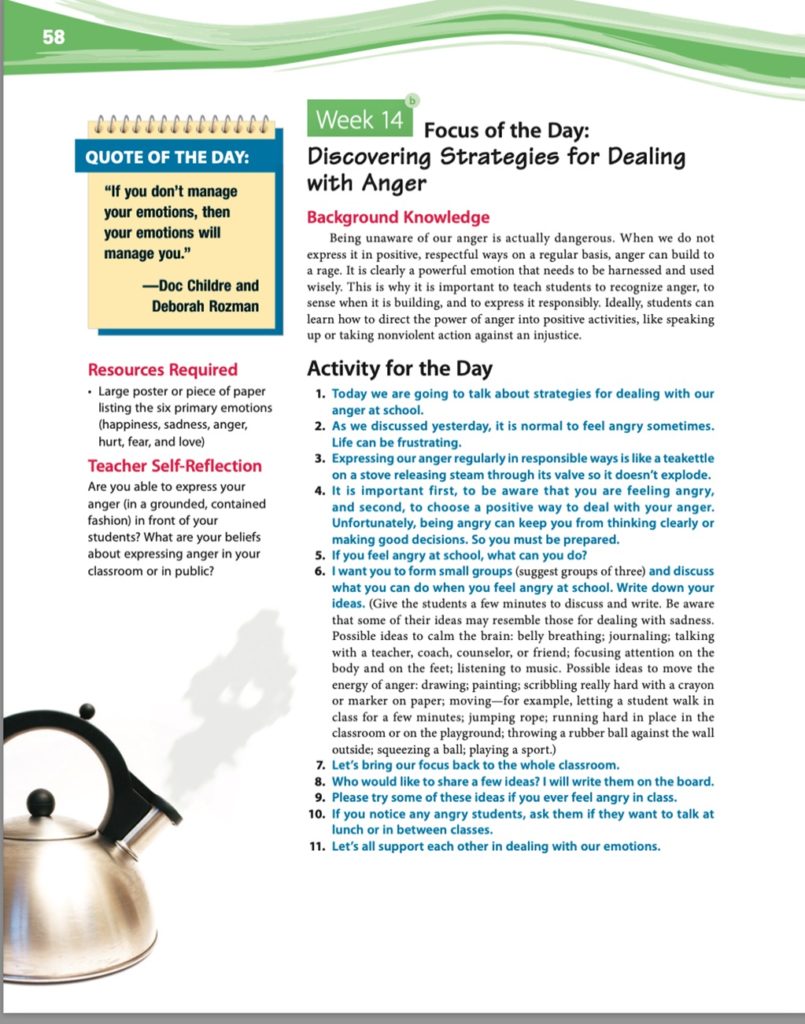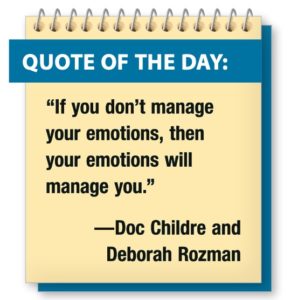by Tom McSheehy MSW, LSW
What do you do when you are angry? Do you take time to teach your students how to manage their anger?
Anger is an empowering emotion, although it has a bad reputation for being expressed inappropriately so often. Anger can give us the energy and courage to speak up, stand up for ourselves, or take some type of positive action. It can create clear, safe boundaries between people.
When we do not address anger, it can affect us unconsciously. We may express anger passively by showing up late for meetings, gossiping, or avoiding interaction. Modeling how to express anger in a contained and grounded fashion can be a valuable lesson for students. Always remember, however, to aim anger at behavior, never at another person’s personality, character, or intelligence.
The emotions of anger, hurt, and fear are the catalyst for violence in our society. Underneath anger is hurt and fear. Teaching your students how to identify and feel their emotions and how to express them constructively instead of destructively is so important. Learning to feel and tolerate the energy of big emotions is not easy. Helping students to discover healthy ways to channel their anger is essential to avoid violence. These anger management ideas need to be practiced frequently so they become habits wired into the brain and easily accessible in times of stress, conflict, and frustration.
Emotion is just energy. Emotion means “energy in motion”. When it is pushed down or ignored, it will come out of us somehow, someway; that is the nature of energy. Movies, TV, family, and cultural beliefs teach us to be tough, react, and fight when we are angry. Anger and violence are often glorified and honored in our society.
Denying and suppressing the energy of anger can lead to rage over time and also cause depression and physical health issues. Learning to manage anger in healthy ways is critically important for mental health. Self-awareness and self-regulation are foundational social emotional learning skills.
Let’s focus in this blog on teaching a lesson on anger management for elementary school students. This lesson comes from my In Focus SEL curriculum that I created.
Here is a picture of an In Focus SEL lesson on anger management. See below for the different parts to the lesson.


Discovering Strategies for Dealing with Anger
Background Knowledge
Being unaware of our anger is actually dangerous. When we do not express it in positive, respectful ways on a regular basis, anger can build to a rage. It is clearly a powerful emotion that needs to be harnessed and used wisely. This is why it is important to teach students to recognize anger, to sense when it is building, and to express it responsibly. Ideally, students can learn how to direct the power of anger into positive activities, like speaking up or taking nonviolent action against an injustice.
Activity for the Day
- Today we are going to talk about strategies for dealing with our anger at school.
- As we discussed yesterday, it is normal to feel angry sometimes. Life can be frustrating.
- Expressing our anger regularly in responsible ways is like a teakettle on a stove releasing steam through its valve so it doesn’t explode.
- It is important first, to be aware that you are feeling angry, and second, to choose a positive way to deal with your anger. Unfortunately, being angry can keep you from thinking clearly or making good decisions. So you must be prepared.
- If you feel angry at school, what can you do?
- I want you to form small groups (suggest groups of three) and discuss what you can do when you feel angry at school. Write down your ideas. (Give the students a few minutes to discuss and write. Be aware that some of their ideas may resemble those for dealing with sadness. Possible ideas to calm the brain: belly breathing; journaling; talking with a teacher, coach, counselor, or friend; focusing attention on the body and on the feet; listening to music. Possible ideas to move the energy of anger: drawing; painting; scribbling really hard with a crayon or marker on paper; moving—for example, letting a student walk in class for a few minutes; jumping rope; running hard in place in the classroom or on the playground; throwing a rubber ball against the wall outside; squeezing a ball; playing a sport.)
- Let’s bring our focus back to the whole classroom.
- Who would like to share a few ideas? I will write them on the board.
- Please try some of these ideas if you ever feel angry in class.
- If you notice any angry students, ask them if they want to talk at lunch or in between classes.
- Let’s all support each other in dealing with our emotions.
Resources Required
- Large poster or piece of paper listing the six primary emotions (happiness, sadness, anger, hurt, fear, and love)
Teacher Self-Reflection
Are you able to express your anger (in a grounded, contained fashion) in front of your students? What are your beliefs about expressing anger in your classroom or in public?
This is a free printable resource to help you teach your students anger management skills and emotional coping skills. If you would like more information about In Focus SEL curriculum, which includes elements like anger management activities for kids, lessons to help kids learn about anger triggers and emotional problem solving, and lessons to teach kids emotional regulation skills, click the link below.
https://teachingheartinstitute.com/in-focus-sel-curriculum/
If you want to stay connected to my social emotional work with teachers, parents, and coaches, click the link below and let me know that you want to receive my Teaching Heart Institute newsletter.
https://teachingheartinstitute.com/contact-tom/
Tom McSheehy, MSW, LSW, taught elementary and middle school for 21 years and has been a licensed social worker for 26 years. Tom is the author of In Focus SEL curriculum and has been working in the area of social emotional learning (SEL) for 36 years.





